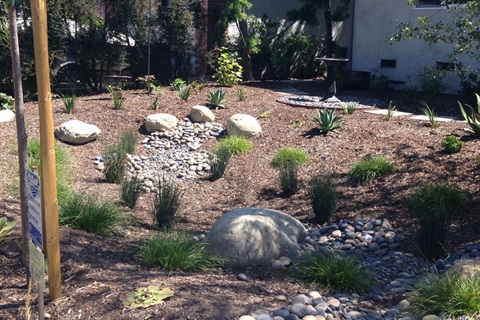How To Build a Rain Garden

A rain garden is a shallow depression filled with 1-3 inch diameter gravel. This shallow depression should have enough of a side slope that the difference between level ground and the lowest point in the rock garden is visible to the eye. Rainwater is stored in the space between the stones and eventually percolates into the soil. Plants are distributed throughout the rock garden and there is no ponding area – so one can walk on it.
Rain gardens can be designed to be aesthetically pleasing and create habitats. Rain gardens tackle the issue of pollution in waterways due to urban runoff by absorbing 30% more storm water into the ground than a conventional lawn and reduce 70% of surface water pollution that originates from storm water runoff.
Follow these steps to build a rain garden:
- Choose the perfect place for your rain garden. Rain gardens help draw away water runoff so they should be placed away from the foundation of your house to prevent drawing water to your foundation. Choose a sunny location at least 10 ft from your house and far away from your septic system if you have one.
- Measure the slope of your selected area. If there is not a 2% slope or more in the area you have selected, create it naturally by digging. Rain gardens capture runoff water, so it is essential that the slope is large enough to allow water to naturally travel into the rain garden.
- Check your soil to ensure that it is permeable enough to allow for water to drain through. To test for permeability, dig a hole in the desired area and pour water into it. If the water remains in the hole for more than a day then the soil is not permeable enough for a rain garden site.
- Size your rain garden. The size of your rain garden varies according to drainage needs as well as the types of soil and native plants you use. Please reference pages 7 and 13 of RaingardenHow2HomeownerUWExtension.pdf (doee.dc.gov) for a detailed guide on how to correctly measure the depth and size of your rain garden.
- Dig your rain garden and build a berm. Use all soil removed from your rain garden to form a short wall around three sides of your rain garden. This wall is called a berm, and will ensure that water remains in your rain garden during a storm instead of flooding the rest of your landscape. Stomp the berm firmly down to ensure the wall is sturdy. Cover the berm with mulch and slope the berm into the surrounding garden to make it less likely to erode, as well as to incorporate the rain garden into the rest of your landscape. Add 1-2 inches of mixed soil and compost to the bottom of your rain garden to prepare to plant.
- Plant your rain garden. Select native mature plants with well-developed root systems which make them more likely to survive in the case of a heavy downpour.
Helpful Tips:
- For the first two years maintain a 2-3 inch layer of mulch in your rain garden to keep it sturdy and resilient in case of heavy rain fall.
- Water your plants in times of drought to ensure their root systems grow into sturdy anchors for the rain garden.
- Inspect your garden regularly to ensure there are no invasive weeds or trash that may inhibit permeability of the rain garden.
Helpful Links: